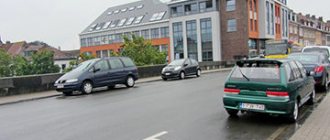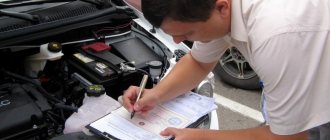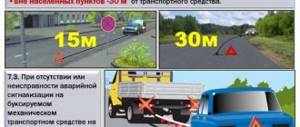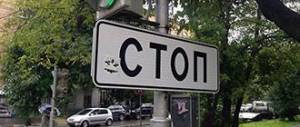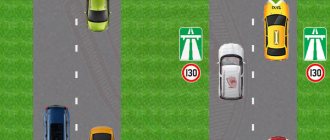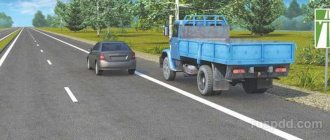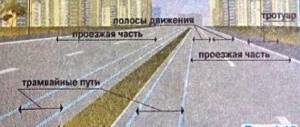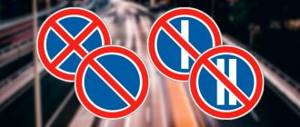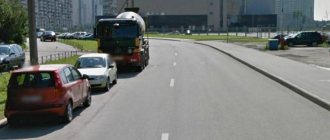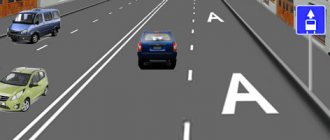During rush hour, you can see how the driver dashes out of the traffic and slows down near a bus or trolleybus stop, taking advantage of the fact that there is always free space on this section of the road. How legal are the actions of such road users, and what are the consequences of such a choice of place to stop?
- How far away can I park? How many meters from and to?
- Payment of the penalty
Is it possible to stop and stand at a bus stop?
According to clause 12.4 of the Traffic Rules of the Russian Federation, the driver does not have the right to park the car near organized public transport stops. The law specifies a specific distance - 15 m (before and after a stationary stop). Thus, a minimum of 15 meters of distance, as well as the designated stopping point itself, must remain free for the access of buses or trolleybuses.
We are talking about parking next to the stop, marked and not marked with special yellow markings 1.17.1 on the asphalt. If there are no markings, you should focus on road sign 5.16 with the image of a bus or trolleybus, which is installed in places intended for public transport stops.
Stopping means keeping the vehicle stationary for 5 minutes. If the car does not move for a longer period of time, the vehicle is considered parked (in the parking lot).
Is it allowed to pick up or drop off passengers?
Yes . There are exceptional situations in which a temporary stop at such areas is permissible. The rules do not prohibit stopping to drop off or pick up passengers, but there is an important caveat: the car must not in any way impede the operation of public transport (arrival or departure of buses, boarding or disembarking of passengers).
The car can be temporarily stopped not only to unload passengers, but also to unload or load things.
You can stop only in those areas where there is no special sign 3.27, prohibiting stopping for any reason.
Forced stop at a public transport stop
The law does not prohibit forced stops:
- in case of breakdown : if the car breaks down and the nearest point where it is possible to park the faulty vehicle is a bus stop, then the driver stops in this zone*;
- in case of a sharp deterioration in health : if the driver suddenly becomes ill while driving, he has the right to stop at any place (including a bus or trolleybus stop) so as not to create emergency and dangerous situations;
- during anti-emergency maneuvers : if the stop occurred as a result of a maneuver aimed at preventing an emergency situation on the road, such a decision by the driver is considered legal.
* If the vehicle breaks down, the driver is obliged to stop the vehicle, place a warning triangle on the roadway and begin troubleshooting. The law contains an instruction: a person driving a faulty car is obliged to take all possible measures so as not to violate the Traffic Rules and not park in places prohibited by law. The law describes specific examples of malfunctions that may cause a stop in an unintended place:
- Malfunction of the brake or steering system.
- Breakdown of windshield wipers (if the weather requires the use of windshield wipers while driving).
- Malfunction of lighting devices (especially if the car is driven at night).
If the driver cannot cope with the problems on his own, you need to call a tow truck or seek the help of a visiting team of specialists.
If the driver becomes ill, it is necessary to notify other road users or passers-by about his condition in any way.
Are taxis allowed to park at stops?
The law makes no exceptions for drivers of passenger taxis: a taxi driver has the right to stop briefly in a public transport area if there is a need to drop off or pick up passengers (unload or load things). It is important not to interfere with buses arriving or departing from a stationary stop.
Polite transport: How to get off at the right stop?
Public transport drivers and passengers share tips on how to miss the right stop.
Journalists learned how to get to their desired destination in modern conditions without any problems. What to do to avoid passing the required stop and what to do if the driver passed it or did not stop, even if you gave a signal.
By definition, a route vehicle (MTS) is a public vehicle (bus, trolleybus, tram) intended for transporting people on roads and moving along a set route with designated stopping places. The stop location can be determined by the corresponding designation at the top left or by the corresponding marking - a “yellow broken line”.
Passengers waiting for transport will have to do this on landing platforms raised above the roadway, and if there are none, on the sidewalk or side of the road. In stopping places for route vehicles that are not equipped with raised landing platforms, it is allowed to enter the roadway to board the vehicle only after it has stopped. After disembarking, it is necessary to clear the roadway without delay.
But not everyone and does not always follow these rules. Thus, a resident of the private sector of Volgograd says that in her neighborhood the rules described above are constantly violated, since passengers are not used to getting off at organized stopping points, but are asked to stop on separate streets, since it is closer for them to get home from there. This is convenient for passengers, but inconvenient for drivers, and violates Part 1 of Art. 11.33 of the Code of Administrative Offenses of the Russian Federation, since boarding a bus, tram or trolleybus or disembarking passengers from a bus, tram or trolleybus in unspecified places - entails the imposition of an administrative fine on the driver in the amount of three thousand rubles, and in case of repeated violation - all five thousand.
If public transport stops are not provided, minibus drivers advise going to the nearest stop. If there is none, then group together near some signs or in places where the minibus can move slightly off the road and not interfere with the movement of other cars.
Passengers who are traveling on public transport and intend to get off at an unidentified stop will have to shout loudly and approach the bus doors in advance to indicate their intention to get off. You can also ask passengers who are closer to the driver to warn him about the need to stop.
In the case of trams, trolleybuses and buses, there are some nuances.
– I needed to get to one building, which is located in an industrial zone. Municipal transport goes there, but it turned out that transport stops there only on request, and I did not know this. The bus flew by and didn’t stop, I had to get off at the next one and go back,” Volgograd resident Alexander told about his unpleasant experience.
According to clause 11 of the Government of the Russian Federation of February 14, 2009 N 112 (as amended on November 10, 2018) “On approval of the Rules for the transportation of passengers and baggage by road and urban ground electric transport”, stopping vehicles for boarding (disembarking) passengers is carried out in all stopping points on the regular transportation route, with the exception of stopping points where passengers are boarded (disembarked) at their request. Stopping vehicles for boarding (disembarking) passengers at their request is carried out if the passenger in the vehicle notifies the conductor or driver in advance about the need to stop the vehicle at the appropriate stopping point or there are persons at the stopping point awaiting the arrival of the vehicle. In these cases, the driver or conductor is obliged to warn passengers in the vehicle in advance about stopping points at which passengers are boarded (disembarked) at their request.
According to driver Sergei, now all buses are equipped with “Signal to the driver” buttons. In order to avoid passing a stop, you need to press the button after the bus has moved a short distance away from the previous one, so that the driver does not think that someone forgot to get off and does not have to brake sharply. You can also approach the driver and ask him to stop “at the next one.”
Dmitry Matveev
PHOTO: online newspaper “Crooked Mirror”
What is the fine for stopping and parking near a bus stop?
In accordance with the provisions of Part 3.1 of Article 12.19 of the Code of Administrative Offenses of the Russian Federation, violation of the rules for stopping and parking vehicles threatens the driver with an administrative fine.
If the driver parked the car at a bus stop or at a distance closer than fifteen meters before or after the stop point, and there was no good reason for such a maneuver from the number of cases defined by law, this entails the imposition of an administrative fine. Currently, the fine is 1,000 rubles.
If parking interfered with the movement of buses, trolleybuses, trams or public transport passengers, the fine will be 2,000 rubles, according to Part 4 of Art. 12.19 Code of Administrative Offenses of the Russian Federation.
If the violation in question was committed in Moscow or St. Petersburg, the amount of the monetary penalty increases to 3,000 rubles based on Part 6 of Art. 12.19 Code of Administrative Offenses of the Russian Federation.
In addition to penalties, the law provides for other measures to punish violators. If the driver left the car at a stop, the vehicle is evacuated to the impound lot , in accordance with Part 1 of Art. 27.13 Code of Administrative Offenses of the Russian Federation. In this situation, the amount of the fine will increase.
In what cases can you park a car at a public transport stop?
Is stopping at a bus stop allowed (can you stop) to drop off passengers? Although the city stop is intended for municipal transport, you can also see ordinary cars there that are not violators. The fact is that the traffic rules (clause 12.4) note a nuance that in some cases allows you to stop at a specified place.
Such cases include:
- Passenger boarding or disembarking (no more than 5 minutes);
- Loading or unloading something (no more than 5 minutes).
But provided that the stopped car does not interfere with public transport.
Exceptions to the rules also include unforeseen emergency “braking” caused by a car breakdown, an accident occurring at a traffic stop, poor health of the driver or the danger of the transported cargo.
In this case, the driver must eliminate the cause as soon as possible by displaying an emergency stop sign. And then free up the city stop for the unhindered movement of public transport.
In other cases, the maneuver is prohibited.
REFERENCE The conditions are easy to remember if you look at the definition of the term “stop”, which means the forced braking of a car for the purpose of boarding or disembarking a fellow traveler, loading or unloading something, but with a time limit of no more than 5 minutes.
If we are talking about such “braking” at a public stop, we must not forget about the main condition - the free movement of municipal transport and the safety of the people waiting for it.
WARNING Also, remember to pay attention to the signs. If at a stop there is a sign 3.27 and continuous markings, the maneuver is in any case unacceptable (is it possible to stand under sign 6.4 with a sign 8.17 and what is the fine for stopping in such preferential parking zones?)
Rules for stopping and parking in traffic regulations
Parking or stopping in the immediate vicinity of a public transport stop must be organized taking into account the requirements of the relevant regulations.
When planning a stop or parking near a stationary stopping point for public transport or passenger taxis, the driver of a passenger vehicle must take into account the following requirements:
- the car can be placed at a distance of no closer than 15 meters to the stop (from any side);
- the distance to the stop is determined by the presence of special yellow markings on the asphalt or by the presence of a road sign (5.16 - 5.18) indicating a stop for public transport or passenger taxis;
- a parked or temporarily stopped car should not interfere with the work and movement of buses, trolleybuses or passenger taxis, or impede the movement of public transport passengers.
How far away can I park? How many meters from and to?
Paragraph 12.4 of the traffic rules states that the minimum distance between a parked or standing car and a public transport stop (on any side) should be 15 meters. The specified interval must be measured from the special instruction sign if there is no marking 1.17.1.
If there is marking 1.17.1, then there is no need to measure 15 m, the main thing is not to stand on this line.
Parking at the tram stop
According to clause 12.4 of the Russian Federation Traffic Regulations, drivers are prohibited from stopping on tram tracks and those areas where stopping (parking) will impede the movement and stopping of the tram, as well as the boarding and disembarking of passengers.
Accordingly, when planning a stop near the tram traffic area, the driver must make sure that:
- the car is not located on tram rails;
- the vehicle is not positioned in such a way that it is impossible for the tram to pass or stop;
- a passenger car does not interfere with tram passengers going to the stop or boarding.
Which stop to get off at?
Today, airport security and police officers did not allow you to work without a passport, with a valid electronic pass, explaining this by the fact that the Prime Minister was arriving today and that everyone had been warned about this, although they found out about this on Friday afternoon, when many were working on reduced hours. working day. That’s not the point - previously they didn’t require a passport, but with the arrival of a new official who wants to curry favor with the authorities and make money from it, they began to announce new orders to us that no one had seen, and to carry out some of them without thinking about the inconveniences, which are created for hundreds of employees of various airport services and ordinary passengers every day. For example, they created such a security strip in front of the airport terminal that there is now no place to park cars for greeters, escorts and employees, even for money. It would have been easier to put up prohibiting parking and stopping signs and enter into an agreement with the traffic police and the towing service for cars that take, or rather steal, private vehicles to a distant area of the city to an impound lot. This happens every day and covers the losses that officials did not count from parking organized by airport services on the territory. And for this they again have a verbal order from the transport police, in connection with the Olympics in Sochi, because. Rostov-on-Don is a reserve airfield for Sochi. Don’t these authorities create too many inconveniences because they simply do not want to fulfill their official duties of inspecting employees and incoming vehicles? And the top officials of the country, whom we serve, guess about the excesses on the ground. Today, while going to work, I identified my pass, but aviation security officers stopped me and demanded to show my passport, explained that the passport was being exchanged due to reaching age, they did not let me through, citing some kind of order, which I demanded to show. However, the police officer assumed authority and said that he was in charge and served the letter flight and this was his verbal order, which was given to him by the police director Kolokoltsev. He wrote down my last name and showed me his service ID. It turns out that only they serve, and the rest of the employees came to work just to show them their passports. After I took out my passport from my bag, which was at the security check, they let me through. And if in fact I exchanged my passport, then a private would come out, even if some police captain could remove me from work, although I could be on the list for servicing this letter flight. In my opinion, this is chaos that we continue to encounter because of excesses and currying favor with the authorities. Please advise where I can post this information to prevent such actions in the future? And how to behave in such cases?
Road signs and markings
Public transport stopping places are indicated by special road signs, according to GOST R 52290-2004:
| № | Sign | Designation |
| 5.16 | Bus and (or) trolleybus stop location. A vertically oriented rectangle with an image of a black bus on a white insert on a blue background. | |
| 5.17 | Tram stop location. A vertical rectangle depicting a silhouette of a tram in black on a white insert on a blue background. | |
| 5.18 | Taxi parking area. A vertically located rectangle with an image of a passenger taxi and a black taxi inscription on a white insert on a blue background. |
The coverage area of the road sign is 5.16 – 5.18 – fifteen meters!
Solid single zigzag line 1.17.1, located along the edge of the roadway, and indicating the stopping place of public transport. Yellow color. Bus and trolleybus stops are marked with similar markings.
Example of marking 1.17.1
Stop zone
The “Public Transport Stop” sign is installed in the place where passengers board and disembark. It is often paired with the sign 8.2.1, which indicates the length of the first sign, most often 10 meters. Also, yellow markings may be applied at pick-up and drop-off points to accurately delineate where the vehicle stops.
Since the “Public Transport Stop” sign belongs to the category of prescriptive, it prescribes a number of actions to the types of transport indicated at the very beginning.
First, they must stop within the sign's coverage area, open the doors and disembark and pick up passengers. Secondly, if necessary, they can make a short-term stop if it is necessary to adhere to the schedule. Thirdly, after making sure that there are no obstacles nearby, continue driving.
Reversing and turning around at stops is prohibited not only for ordinary cars, but also for public transport. Moreover, the ban applies to a territory with a radius of 15 meters from the area of effect of sign 5.16.
Based on this, in order to turn around, for example, a minibus must find a place where this maneuver is not prohibited. This could be an intersection or a roundabout.
What to do if the inspector issues a fine?
If you happen to stop or park in violation of the rules, a traffic police inspector may approach the driver to issue a fine. What to do in this situation? The driver has two options: pay the fine or try to appeal the inspector’s decision.
Payment of the penalty
If it is not possible to prove that the stop occurred for a good reason (and this will have to be proven; police representatives reasonably do not trust words), a fine will be issued. A representative of the traffic police will draw up a report on the offense and support the document with the testimony of witnesses. The imposed fine will need to be paid in accordance with the procedure established by law within two calendar months. The sixty-day period starts 10 days after the offender receives the official notification. If the driver has the opportunity to pay the fine within 20 days from the date of the offense, the amount will be halved (Part 1.3 of Article 32.2 of the Code of Administrative Offenses of the Russian Federation).
Please note that evading payment of an administrative fine within a certain time frame is another offense that will entail additional sanctions.
If the fine is not paid on time, the unscrupulous road user will have to (by court decision):
- pay double the fine;
- fall under administrative arrest (for up to 15 days);
- perform forced labor (within 50 hours).
